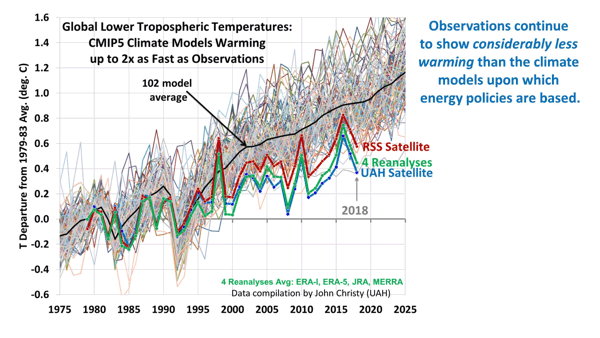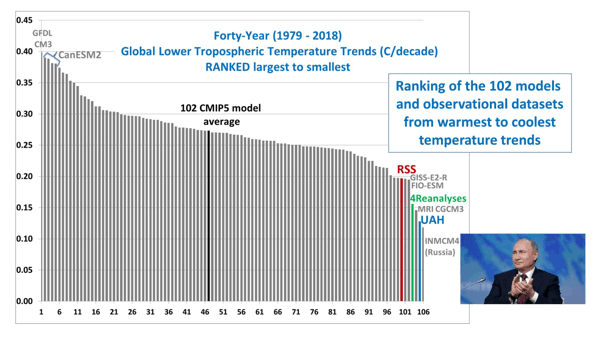Important update from Spencer & Christy
A few days ago Drs Roy Spencer and John Christy published updated graphs they first presented to a Heartland conference in July. Roy says:
I keep getting asked about our charts comparing the CMIP5 models to observations, old versions of which are still circulating, so it could be I have not been proactive enough at providing updates to those. Since I presented some charts at the Heartland conference in D.C. in July summarizing the latest results we had as of that time, I thought I would reproduce those here.
The following comparisons are for the lower tropospheric (LT) temperature product, with separate results for global and tropical (20N-20S). I also provide trend ranking “bar plots” so you can get a better idea of how the warming trends all quantitatively compare to one another (and since it is the trends that, arguably, matter the most when discussing “global warming”).
From what I understand, the new CMIP6 models are exhibiting even more warming than the CMIP5 models, so it sounds like when we have sufficient model comparisons to produce CMIP6 plots, the discrepancies seen below will be increasing.
Here’s the main graph, which confirms that the models are considerably warmer than observations—all but that one Russian model underneath them all (the grey line through the final UAH data point): Keep in mind that those peaks of warming reaching up into the model spaghetti don’t represent a warming trend. They’re temporary increases caused by El Ninos that move briefly up and back down again.
Keep in mind that those peaks of warming reaching up into the model spaghetti don’t represent a warming trend. They’re temporary increases caused by El Ninos that move briefly up and back down again.
Then there’s this illuminating view of models and observations ranked by warming trend where Roy inserts a picture of an applauding Putin with a cheeky quip about Russian collusion. He says:
The ranking of the trends in that figure shows that only the Russian model has a lower trend than UAH, with the average of the 4 reanalysis datasets not far behind. I categorically deny any Russian involvement in the resulting agreement between the UAH trend and the Russian model trend, no matter what dossier might come to light.
 When you stand plainly on the side of science and truth excursions into comedy won’t harm your cause.
When you stand plainly on the side of science and truth excursions into comedy won’t harm your cause.
But the warmsters take themselves too seriously and are clearly losing the battle, reduced to studying the “sickness” and “mental illness” of climate sceptics—even accusing them of “misogyny“. They don’t appreciate that claiming their opponent is sick just irritates them and that presenting facts is the only way to change minds.
Views: 248

Spencer and Christy are comparing troposphere measures with surface temperature forecasts. They are not the same thing. Here is a valid comparison:
![]()
https://pbs.twimg.com/media/Cp_cKSGXYAA1e6P?format=jpg&name=medium
Sure, thanks, Simon, but you bring data that ends in about 2015 or 2016 in a graph labelled 1979-2020, in the future. You put about 27.3 ticks per ten years on the X-axis, making it pretty hard to know when things happened, you compare 102 specified models with 38 unnamed models, and you don’t mention its provenance. You cannot call that a valid comparison. The result bears some similarity to the Spencer effort, apart from the wild vertical excursion at the end of your data, and you have three years to go, but I’m not sure what your point might be.
https://tamino.wordpress.com/2018/02/02/surface-temperature-and-satellite-temperature/
Surface Temperature and Satellite Temperature
Posted on February 2, 2018
One of the myths about temperature data is the ludicrous notion that the data for atmospheric temperature from satellites are better than the surface data from thermometers. We’ve heard this from people who should know better, like John Christy and Judith Curry, and climate denier politicians like Ted Cruz. The problem is, it just ain’t so.
==================
_______________________
https://en.wikipedia.org/wiki/Satellite_temperature_measurements
Satellites do not measure temperature. They measure radiances in various wavelength bands, which must then be mathematically inverted to obtain indirect inferences of temperature.[1][2] The resulting temperature profiles depend on details of the methods that are used to obtain temperatures from radiances. As a result, different groups that have analyzed the satellite data have produced differing temperature datasets. Among these are the UAH dataset prepared at the University of Alabama in Huntsville and the RSS dataset prepared by Remote Sensing Systems.
The satellite time series is not homogeneous. It is constructed from a series of satellites with similar but not identical sensors. The sensors also deteriorate over time, and corrections are necessary for orbital drift and decay.[3][4] Particularly large differences between reconstructed temperature series occur at the few times when there is little temporal overlap between successive satellites, making intercalibration difficult.[citat
Good stuff Nick and well-known to us. We also know and have experience here of some of the thermometer and water bucket temp record data tamperers. Luckily we have other scientists on the job; Geologists and Palnyologists for example.
We also have the Ice Cores’ record of cold always preceding CO2 decrease and vice versa. Etcetera.
Looking forward to an honest and earnest contribution from you…………. Brett Keane
Nick,
You quote stuff from Tamino I didn’t cite, then bring an argument from Wikipedia I didn’t raise. Tamino: I haven’t read your reference, but if actual climate scientists are satisfied with the idea of the UAH/RSS teams using the microwave sounding units to detect temperatures in bands of the atmosphere, I’m happy to accept it. If you disagree, by all means publish it yourself. Wikipedia: I guess this is the same idea as Tamino discusses.
Could you discuss the post, please? It makes a not unreasonable point about overheating models getting further away from observations.
https://notrickszone.com/2020/01/02/unsettled-scientists-find-ocean-heat-content-and-earths-energy-imbalance-in-decline-since-2000/
https://www.forbes.com/sites/rogerpielke/2020/01/02/how-billionaires-tom-steyer-and-michael-bloomberg-corrupted-climate-science/#51f5e990702c
And all the bought and sold trolls keep on fooling themselves. Just plain evil. Brett